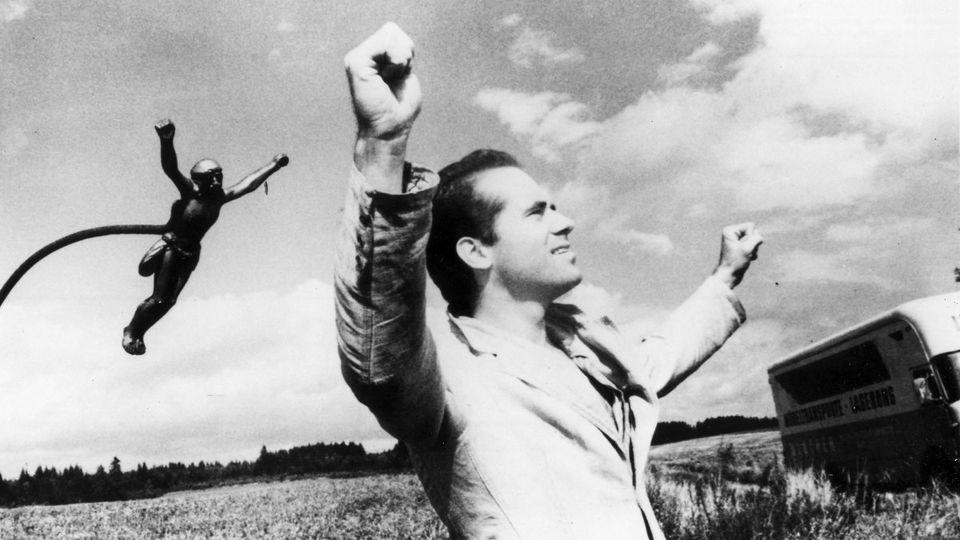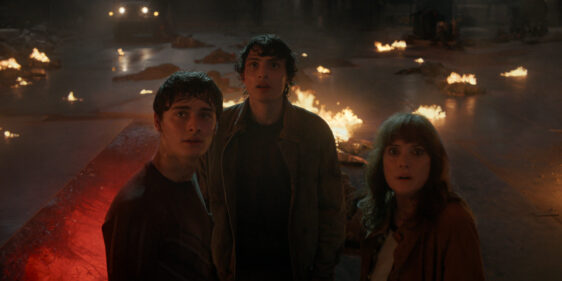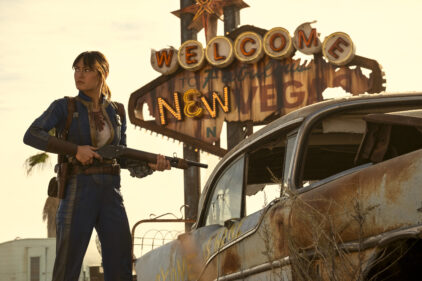One of the most significant cultural events of 2015 was “Wim
Wenders: Portraits Along the Road,” a touring retrospective put together by
Janus Films. It featured 12 of the most significant titles from the acclaimed director’s
extensive filmography, ranging from the early works that made him one of the
leading voices of the German new wave in the early 1970s to such
international hits as “Paris, Texas” and “Wings of Desire” to a rare
presentation of the extended director’s cut of his epic “Until the End of the
World.” Now, having already put out stellar editions of “Paris, Texas” and
“Wings of Desire,” the Criterion Collection has begun giving the rest of the
films in the retrospective their long-awaited Blu-ray due. Earlier this year, they put out a highly regarded edition of “The American Friend,” his
adaptation of “Ripley’s Game,” the Patricia Highsmith novel featuring her
beloved anti-hero Tom Ripley. Now, they have produced “Wim Wenders: The Road Trilogy,” a three-disc collection bringing together “Alice in the Cities”
(1974), “Wrong Move” (1975) and “Kings of the Road” (1976), films that
essentially launched his career on the international film scene and which also
earned him recognition as a master of one of the most beloved of cinematic
sub-genres, the road movie.
“Alice in the Cities” stars Rüdiger Vogler as Philip Winter, a
German journalist who has come to America with the hopes of writing something of
significance about the country that fascinates him so. Alas, he has been unable
to conjure up anything more than a series of undistinguished and virtually
unpublishable Polaroid photos, and he is about to return home. The day before
his departure, he meets a woman and her young daughter, Alice (Yella
Rottländer), who are also leaving on the same flight. When the mother is
delayed at the last second on business, Winter agrees to take Alice with him on
the flight and then wait for her mother to catch up with them in Amsterdam.
When the mother fails to show up, Philip is stuck with Alice and finds himself
taking the girl through a number of German cities in the hope of finding a
grandmother whose name and address she cannot remember and with nothing to go
on but a photograph of a front door. At
first, the two do not get along but as their journey progresses, they begin to
grow on one another and Winter begins to shed some of the disillusionment that
he felt on his journey in America and begins to see his surroundings in a new
light.

Although technically his fourth feature film (following “Summer
in the City,” “The Goalie’s Anxiety at the Penalty Kick” and a fairly
disastrous adaptation of “The Scarlet Letter”), it is tempting to look at
“Alice in the Cities” as Wenders’ true debut work. It was the first film to
feature the character of Philip Winter, who would go on to appear in a number
of Wenders’ films over the years; it was also the first of his movies to be shot in
the United States, a country whose culture and behaviors Wenders would explore
in many of his subsequent works; and it was his first full-fledged road movie.
On the surface, it sounds like the plot of an exceptionally corny family film
along the lines of the kid-oriented titles from the John Hughes oeuvre. The
mismatched pair do eventually bond but it is in a more metaphysical manner that
stresses Winter’s reconnection with a world with which he has lost touch.
Similarly, Wenders avoids the easy choice of portraying America as some kind of
empty social and cultural void when compared to Europe—Wenders is clearly in
love with American culture (especially the films and rock music) and it is only
when Winter has returned to Europe and to his own inner self that he is finally
able to appreciate the qualities that he wasn’t able to fully connect with when
he was there. Although arguably the most dated of the three films in the
set—beyond the obvious technological advances, it seems highly unlikely that
anyone could get away with a movie in these times in which a young girl is
arbitrarily placed in the hands of a grown man she hardly knows—there is a
timelessness to its explorations that makes it as rich and resonant today as
when it was first released.
Working from a screenplay by Peter Handke, whom he worked with on
“The Goalie’s Anxiety at the Penalty Kick” and who he would later collaborate
with on “Wings of Desire,” that was itself loosely inspired by Johann Wolfgang
von Goethe’s “Wilhelm Meister’s Apprenticeship,” Wenders followed up “Alice in
the Cities” with “Wrong Move.” In this one, aspiring author Wilhelm (Vogler
again) departs from his hometown in the far north of Germany, leaving his
mother and girlfriend behind, to travel to Bonn. After changing trains in Hamburg,
he finds himself sharing a compartment with the aging Laetes (Hans Christian
Blech) and his young companion Mignon (Nastassja Kinski, making her screen
debut at the age of 13), a seemingly mute acrobat, and befriends them to the
point where he pays for their train fare and to stay with him at a hotel.
There, they are joined by Therese (Hanna Schygulla), an actress whom he
flirted with during the Hamburg stopover, and Berhard (Peter Kern), a would-be
poet who offers to let them all stay with him at a castle belonging to his rich
uncle. When they arrive, however, it is the wrong castle, but the owner, who
was just about to commit suicide when they arrived, welcomes them in.
Everything is fine for a while, but before long, certain tensions begin to
develop amongst them (Wilhelm refuses to romantically pursue Therese while
becoming the target of Mignon’s affections and Laertes shocks Wilhelm by
revealing some details about his participation in the Holocaust) and Wilhelm
eventually leaves them all to complete his journey, literally and figuratively,
by arriving at Germany’s southernmost point.

Of the three films in the trilogy, “Wrong Move” is probably the
hardest one for contemporary audiences to warm up to. It is, at its heart, a
story of a would-be writer grappling with trying to figure out how to process
his thoughts, feelings and experiences in ways that can be both edifying and
entertaining and the various characters who glom on to him can be read as the
different potential narrative viewpoints that he could apply as part of his
process. From an intellectual standpoint, that is an intriguing concept but the
end result is sometimes a little too dry and airless for its own good,
especially in comparison with the effortless charms of “Alice in the Cities.” In
addition, the political situation of Germany in the mid-1970s plays a
significant part in the proceedings and that aspect inevitably winds up dating
the film. And yet, there are still a number of glories to be had here. The
journey taken by Wilhelm and his companions is beautifully captured by
cinematographer Robby Müller in ways that are oftentimes more expressive than
the screenplay. Of course, “Wrong Move” is most famous today for marking the
screen debut of Kinski and indeed, she is the most memorable thing about it
despite the occasionally troubling nature of her character’s storyline. Even at
her young age, it was clear that she had the kind of rare combination of
talent, beauty and raw screen charisma that forced viewers to sit up and take
notice that a new star was born. (Kinski would, of course, go on to reunite
twice with Wenders, first in her heartbreaking turn as the missing wife in the
masterpiece “Paris, Texas” and as an angel in the underrated “Wings of Desire”
sequel “Faraway, So Close!”)
Clocking in at nearly three hours, “Kings of the Road” would
prove to be Wenders’ first epic-length film as well as his first unquestioned
masterpiece, though one of a decidedly unusual variety. Once again starring
Rüdiger Vogler, this film finds him playing Bruno Winter, a traveling film
projector repairman who travels from one remote theater along the West/East
German border to the next plying his trade. While going about his way, he
stumbles upon Robert (Hanns Zischler), a depressed psychologist who has just
tried to kill himself following a breakup by driving his car into a river—alas,
he was driving a Volkswagen at the time. Robert decides to get a ride with
Bruno and over the course of the next week, they drive around, largely in
silence, listen to rock music and visit a series of dilapidated theaters
clearly designed to represent the waning of the local film industry in the wake
of the increasing influence of American entertainment. Along the way, they
begin to learn about life and love and the importance of communication and of
getting beyond ones past in order to face the future.

This might not sound like the most gripping narrative for a film,
especially one clocking in at just under three hours, but every time I have
seen “Kings of the Road” over the years, I have never been anything less than completely captivated with it. By far the least structured of the films in this
trilogy—it is said that the initial meeting between Bruno and Robert was the
only scene that was fully scripted and that everything else was largely
improvised—there is an undeniably fascinating freedom to what Wenders captures. As the two characters bomb around from town to town, they are
ostensibly looking for themselves while grappling with their mutual
estrangement from both women and the world they once knew. It is only
through their fumbling attempts to come to terms with the latter are they able
to begin achieving the former. The story goes from moments of true poignancy to
rude humor (including one surprisingly scatological sequence) to quiet tension
(including a scene in which the two spend the night in an abandoned bunker that
is a little too close to an East German guard tower for conflict) to moments
where Wenders indulges in his passions for rock music and the cinema and while
there are inevitably a few dead spots here and there, “Kings of the Road”
proves to be such a compelling cinematic experience that it could have gone on
for another hour or two and I daresay that few viewers would have noticed or minded.
For various reasons, mostly involving inferior elements and
rights issues involving the jam-packed soundtracks, the three films featured in
“The Road Trilogy” have been difficult to see on video in America in recent
years but this extras-packed package more than makes up for that. All three
films received 4k digital transfers under the supervision of Wenders himself
and they all look spectacular—even though these were amongst his first films as
cinematographer, it was obvious that Robby Müller was going to be one of the
greats in his profession. Each film contains an audio commentary with
Wenders—joined on “Alice in the Cities” by co-stars Rüdiger Vogler and Yella
Rottlander—that are conducted in German with English subtitles. “Alice in the
Cities” also includes “Same Player Shoots Again” and “Silver City Revisited,”
two short films by Wenders predating his feature work, new interviews with
Vogler, Rottlander and Lisa Kreuzer, a selection of outtakes and “Restoring
Time,” a 2015 short chronicling the restoration process conducted on the films
by the Wim Wenders Foundation. “Wrong Move” includes a new interview with
Wenders conducted by Michael Almereyda, additional new interviews with Vogler
and Kreuzer and behind-the-scenes Super 8 footage. “Kings of the Road” includes
new interviews with Vogler, Kreuzer and Hanns Zischler and a series of
outtakes. The set also includes a booklet containing essays on the films and
Wenders by Almereyda, filmmaker Allison Anders, author James Robison and critic
Nick Roddick. As vast, ambitious and compelling as the films that it collects,
“Wim Wenders: The Road Trilogy” is pretty much a must for cinephiles of all
stripes and should prove to be one of the most valuable home video releases of
the year.












